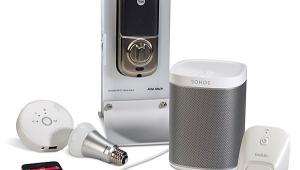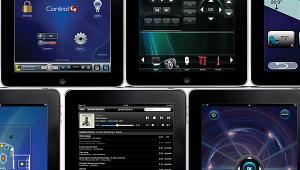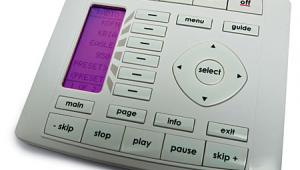Logitech Harmony 688 & 676 Universal Remotes Page 2
The silver Harmony 688 has the same slim peanut shape as the earlier 659 and the newer 676, with an LCD screen flanked by six "soft" buttons near the top, a 4-way navigation ring with central OK button in the middle, and number buttons near the bottom. Above the LCD are four Activity buttons—Play Video, Play Music, Watch TV, Watch DVD—and a More button that displays more activities in the LCD, which are selected with the corresponding soft buttons. Arrayed in an oval around the central navigation ring are various buttons, such as Volume and Channel Up/Down, Mute, Menu, Guide, etc.; between these and the number buttons are the transport controls. More individual controls for each device can be displayed and activated on the LCD.
 One of my major complaints about the 659 was that it was not well designed to control digital video recorders (DVRs) such as TiVo. The 688 addresses this problem by putting the transport controls nearer the center of the remote. However, there is a serious drawback: various groups of buttons (transport, oval, numbers, etc.) are molded from a continuous piece of plastic, with only slight grooves and bumps to differentiate them by touch. This makes it nearly impossible to find a particular button in the dark, even after memorizing their location. Of course, you can turn on the backlight, but that wastes battery power and distracts your attention from the screen.
One of my major complaints about the 659 was that it was not well designed to control digital video recorders (DVRs) such as TiVo. The 688 addresses this problem by putting the transport controls nearer the center of the remote. However, there is a serious drawback: various groups of buttons (transport, oval, numbers, etc.) are molded from a continuous piece of plastic, with only slight grooves and bumps to differentiate them by touch. This makes it nearly impossible to find a particular button in the dark, even after memorizing their location. Of course, you can turn on the backlight, but that wastes battery power and distracts your attention from the screen.
Harmony 676
Logitech finally got it all right with the Harmony 676. The button locations are excellent: transport below the LCD, menu-access buttons surrounding the central navigation ring, volume and channel just below that, number buttons at the bottom. Just as important, these are all separate buttons, which makes them much easier to find by feel than on the 688. Most of the buttons are the same shape, which doesn't help the feel factor, but they're well spaced, even for large fingers such as mine, and the most commonly used controls are within easy reach of the thumb while holding the remote in one hand.
Identical in shape to the 688, the 676's silver-and-black countenance can be overlaid with a red or a blue skin, both of which are included. There are three dedicated Activity buttons above the LCD, as opposed to four on the 688; on both units, a More button displays other activities in the LCD to be selected with soft buttons. The dedicated Activity buttons are labeled, but like everything on the Harmony remotes, they are completely and easily user-assignable.
When I first set up the 676's Watch TV activity, the transport controls didn't work with my Pioneer DVR-57H TiVo/DVD recorder, which is what I normally use to watch NTSC TV, and I was unable to find out why from the website's automated troubleshooter. A call to tech support was quickly answered, and I learned that Watch TV doesn't automatically map the transport controls. There were two solutions: use the Watch TiVo activity or manually assign the corresponding IR codes to those buttons. I'm glad to say that Logitech has continued to provide the exceptional human tech support that has been an integral part of the Harmony philosophy from the beginning.
I decided to try the latter course, and found it very easy to select the right code from a popup list next to each button in a picture of the remote. However, assigning the Menu command to the remote's Menu button didn't work. A second call to tech support revealed that I needed to assign the TiVo command. Alright, fine, but would most people know that? I didn't. The programming should automatically assign the TiVo command to the Menu button if the source device is a TiVo.
Such minor quibbles aside, the only major thing on my wish list is RF capability. Like most universal remotes, the 676 uses infrared (IR) light pulses to control the equipment, and it must be aimed at the equipment you are trying to control. The IR beam from all of the Harmony remotes covers a wide angle, which is especially important in rooms like my theater, where the display is in the front and the component rack is at the side. In such a situation, you need to aim the remote between the two areas so the IR signals reach everywhere they need to. And in all cases, the remote needs a clear line of sight to the equipment; if there's something or someone in the way, some of the gear won't receive the signal. Once the obstacle is moved, the Harmony SST system can easily correct any problems, but having to properly aim the remote is less than ideal.
The 676 does as good a job as an IR remote can of getting the signal to the gear, thanks to its wide-angle dispersion. But an even better (though more expensive) solution is to have the remote send radio-frequency (RF) signals to a base station, which can be positioned to flood all equipment areas with IR signals. Alternatively, the base station can provide several outputs to which individual IR blasters can be connected and routed to the IR eyes on the components. The latter configuration removes any concern about obstacles getting in the way of the IR signals, but it also means stringing more wires around the system, which I prefer to avoid. In either case, the remote itself needn't be aimed in any particular direction, or even be in the same room. I don't know if the 676's physical design can accommodate the circuitry for RF operation—I wouldn't want it to get much bigger—but this would increase its flexibility even more.
Conclusion
The Logitech Harmony 676 boldly goes where no IR universal remote has gone before, far surpassing any such product I've ever tried—and I've tried quite a few. It's perfectly balanced and shaped for one-hand operation, providing ease of setup, excellent system integration, and logically placed and well-spaced buttons. Combine that with the SST power- and input-sync system and a fantastic tech-support team, and you've got the ultimate IR universal remote. They'll get mine when they pry it from my cold, dead—but comfortable—fingers.





























































